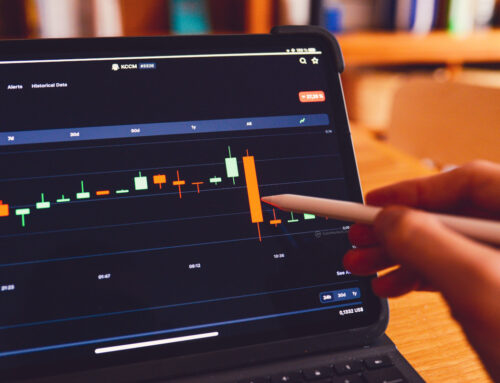As you conduct analysis on stocks, there are so many different forms of analysis you can use. We’ve covered all the best indicators for swing trading in a separate blog post. But, did you know you can also use different time frames when analyzing stocks and looking at these indicators?
Looking at the different chart time frames gives you more insights than if you were to only look at a single time frame. You wouldn’t get the full picture. But the last thing you want to do is get stuck in analysis paralysis, looking at different charts all day instead of actually taking action and executing trades. So – what is the best time frame for swing trading? That’s exactly what you’ll discover in this blog post.
We’re going to break down the different chart time frames you can leverage in your analysis. We’ll also explain which of these are best so you can use your time and resources wisely. And, you’ll gain insights into how to actually use the different time frames to get the most out of them. Towards the end, we’ll introduce you to a simple way to analyze stocks and win more trades. First – a brief introduction to charts, time frames, and swing trading in general.
Featured Courses:
A Quick Explanation of Charts, Time Frames, & Swing Trading
To help you fully grasp the importance of using the best time frames for swing trading, we want to give you a brief overview of charts, time frames, and swing trading. There are two types of charts you can use when swing trading: candlestick charts and bar charts. Candlestick charts give you more insights because they show the opening, closing, high, and low prices for a stock. Bar charts only show the closing price.
Time frames are how long each candlestick or bar on your chart represents. For example, if you’re looking at a daily chart, each candlestick would represent one day of trading action. If you’re looking at a weekly chart, each candlestick would represent one week of trading action. There are also monthly and yearly time frames.
Swing trading is taking trades that last anywhere from a few days to a few weeks – usually no longer than a month. The goal is to capitalize on price swings in the market. When you buy low and sell high, you’re participating in swing trading. And, what makes swing trading really unique is that you can still make a profit on the short-term swings along a stock’s overall downward price trajectory. This means technical analysis is the primary means by which you’ll uncover opportunities and execute upon them. As such, you can’t overlook the importance of using the best time frames for swing trading.
Why Using the Best Time Frames for Swing Trading is So Important
Now that we’ve given you a brief introduction to charts, time frames, and swing trading – let’s dive into why using the best time frames for swing trading is so important. It all comes down to your success rate as a trader. If you want to be successful in any field, you need to put yourself in the best position for success – and part of that is using the best tools available.
When it comes to swing trading, using the best time frames will help increase your success rate because it allows you to make more informed decisions. If you’re looking at a daily chart and trying to make trade decisions based on that, you’re not going to be as successful as someone who’s looking at a weekly or monthly chart. Why? Because you simply don’t have enough information to make an informed decision.
The best time frames for swing trading give you the most information possible so you can make the best decisions possible. This doesn’t mean you should only look at a single time frame chart, but rather use multiple time frames in your analysis. We’ll cover that shortly. For now, just know that using the best time frames is crucial if you want to be successful in swing trading.
What are the Different Time Frame Charts for Swing Trading?
We’ve briefly touched on the daily, weekly, monthly, and annual chart time frames, but there are many others. For example, you can also use intraday time frames such as the five-minute, fifteen-minute, thirty-minute, and one-hour charts. There are also tick charts that show a certain number of transactions per unit of time.
The best time frame for swing trading also depends on the markets you’re trading. For example, if you’re trading forex, you might want to use a different time frame than someone who’s trading stocks. This is because the forex market is much more volatile than the stock market and moves at a much faster pace. We typically discourage swing traders from dabbling in forex for this exact reason, though.
So – What is the Best Time Frame for Swing Trading?
So – what is the best time frame for swing trading? Various trading styles will benefit most from different chart time frames – if you’re a day trader, you’re going to want to use an intraday chart. If you’re more of a position trader, you’re going to want to use a daily or weekly chart. And if you’re a long-term investor, you might even use a monthly or yearly chart. It all depends on your goals as a trader and how much time you have to dedicate to trading.
The best time frame for swing trading in particular is typically the daily or weekly charts. This gives you enough information to make informed decisions without being overloaded with data. Remember – you’re not concerned with the minute-by-minute changes in a stock’s price like a day trader may be. And, you’re not concerned with a stock’s price over the course of a month or a year.
Now – does that mean you never need to look at any chart beside a daily or weekly chart? Definitely not. You can still use longer-term charts to make informed decisions and identify potential entry or exit points. Using multiple time frames in your analysis helps you gain a better understanding of the market. For example, you might look at a daily chart to find trends and identify support and resistance levels, but then use a fifteen-minute chart to time your entries and exits. This is called multiple time frame analysis and is a great way to increase your success rate as a swing trader.
Simplify Investing with VectorVest – No Matter Which Chart Time Frame You Prefer!
There’s no doubt that swing trading can be profitable, but it’s not for everyone. It takes dedication, discipline, and most importantly – the right resources. We’ve got great resources to help you learn how to swing trade – such as our in-depth blog posts on how swing trading works, swing trading strategies, when to sell swing trading stocks, and more.
But at a certain point, you need to take action and start investing – even if you start swing trading with a small account. To really set yourself up for success, you need to invest in the right tools – like a stock forecasting software. This is where VectorVest comes in.
Our tools help investors simplify fundamental and technical analysis into three simple, easy-to-understand ratings: relative value (RV), relative safety (RS), and relative timing (RT). These make up the overall VST rating a stock is given – and from there, we’re able to give you a clear buy, sell, or hold rating. This helps you win more trades, keeping your losses small and infrequent. You can use all the different time frame charts in our software – but frankly, the analysis we do for you is more than enough to help you uncover opportunities and execute your trades to perfection. To see the system in action, get a free stock analysis today.
Parting Thoughts on the Best Time Frames for Swing Trading
Now that you know what time frames to use for swing trading, you’re ready to start using multiple time frame analyses in your investment strategy. There’s no one-size-fits-all answer to the best time frames for swing trading – however, we typically encourage traders to rely on daily or weekly charts when swing trading stocks. Using intraday time frames can be overwhelming – and frankly, doesn’t provide you with the insights you need as a swing trader. On the other hand, monthly or annual time frames are zoomed out too far – and won’t help you identify your window of opportunity.
Remember – you’re not concerned with the minute-by-minute changes in a stock’s price like a day trader may be. And, you’re not concerned with a stock’s price over the course of a month or a year. You’re looking for opportunities to buy low and sell high – over the course of just a few days – or a week or two at most.
There is no better investment than in yourself – which is why setting yourself up with the right tools is the best way to enjoy a high rate of success as a swing trader. Take a look at our desktop software or our mobile stock advisory and experience effortless, emotionless investing. You’ll never go back to traditional analysis!






Leave A Comment